If you are wondering where to see kiwi in New Zealand, you have come to the right place. We have personally seen them in over a dozen locations, heard them at others, and Jeff participated in one kiwi bird release, returning them to the wild.
Loved by a nation, the kiwi bird is odd-looking, flightless, nocturnal and endemic to New Zealand. Even the Little Spotted Kiwi, the smallest of the species, is much larger than I expected.
Both in the wild and in nocturnal enclosures, kiwi forage forest floors on both the North and South Islands.
Seeing them in the wild is rare and generally requires either a guide, good luck, or often both. But they are out there. And when we are patient and quiet (and in the right place), we can often hear their distinctive shrill call just after dark.
If seeing a kiwi in New Zealand is on your bucket list, it is probably easier than you think. Below are the best places to see kiwi birds in New Zealand.
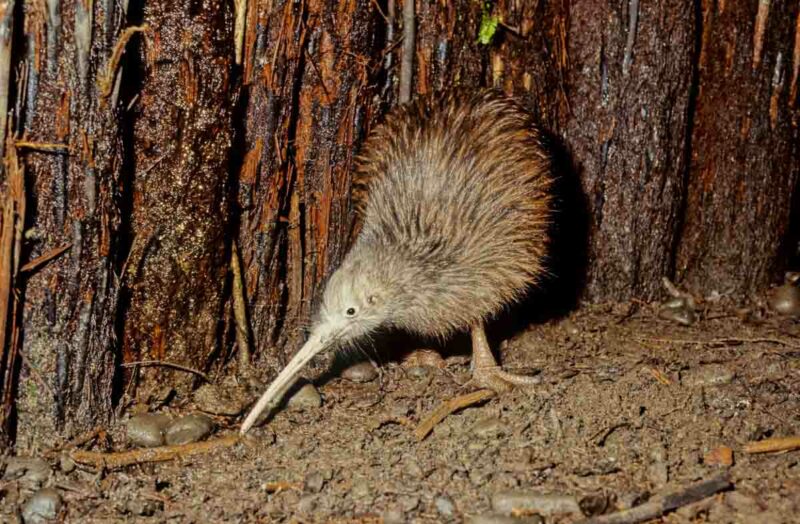
Map of where to see kiwi in New Zealand
In our map, green indicates nature reserve, while orange is for those with a nocturnal house. Click the expand / collapse icon in the upper left corner of the map for details.
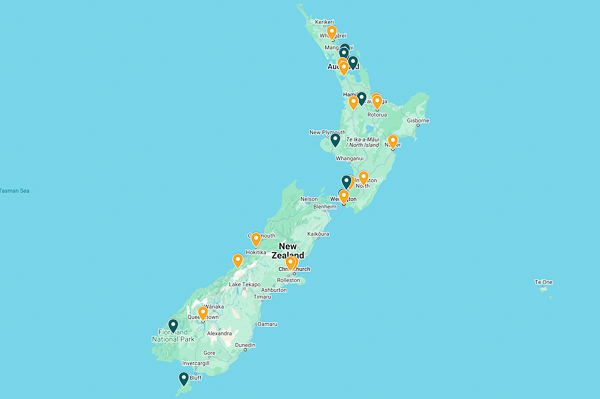
Check out this kiwi spotted in the daytime on Stewart Island …
Species of kiwi bird in New Zealand
Endemic to New Zealand, there are only five species. You can read more about each here.
- North Island brown kiwi (Not threatened)
- Great spotted kiwi/roroa (Threatened – nationally vulnerable)
- Little spotted kiwi/kiwi pukupuku (Threatened- nationally increasing)
- Rowi (Threatened – nationally endangered)
- Tokoeka (Threatened – nationally vulnerable)
Where to see kiwi in New Zealand: Dedicated facilities
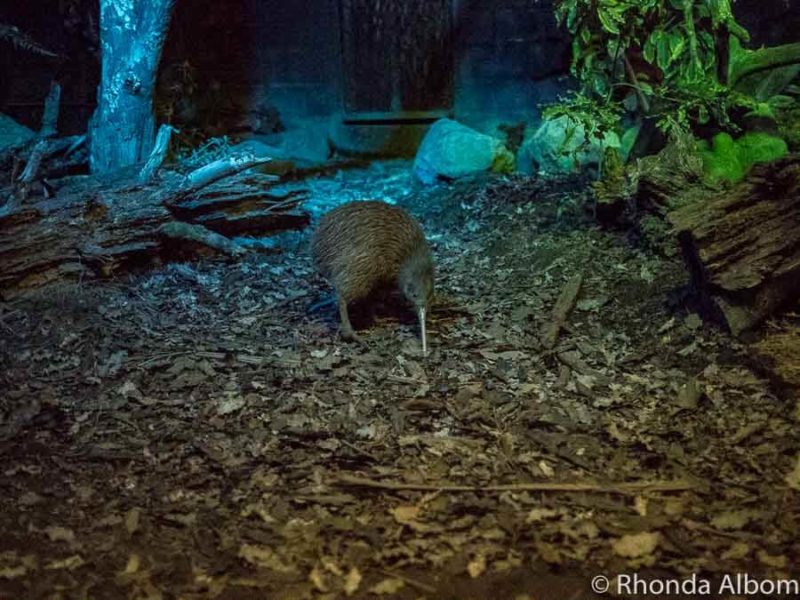
At each of these conservation locations, we found nocturnal houses that allow these iconic birds to live in a simulated natural habitat while they are protected from predators and well cared for. These enclosures give visitors a chance to see, learn about, and be fascinated by their uniqueness (this has always been my experience).
Kiwi North, Whangarei
Whangarei’s Kiwi North is a multifaceted attraction combining a museum, a heritage park, and a nocturnal kiwi house (the only one in the Northland region). The facility is home to a non-breeding pair of North Island brown kiwi. It’s one of many cool things to do in Whangarei.
National Kiwi Hatchery, Rotorua
This purpose-built conservation facility is the country’s only open-to-the-public kiwi hatchery and rearing facility. While we don’t encounter adult kiwi here, witnessing the fragile beginnings of these iconic birds is a heartwarming experience. Reserve your National Kiwi Hatchery tour here.
Otorohanga Kiwi House, Otorohanga
More than just a kiwi house, it is NZ’s largest private collection of native birds. We visited both of their nocturnal kiwi houses, each housing two birds. With the aid of the keepers, we were able to spot them all. There are no photos allowed inside the kiwi house, so we took the photo of the lifesize display model just below instead.
Otorohanga Kiwi House is an active breeding facility that has been conserving kiwi since 1971. Releases to preditor-free locations are frequent and impressive.
If you are seeking an adventure, you could stop here on your way from Auckland to the Taranaki region (like we did) or take a day trip from Auckland that includes a couple of other amazing things nearby.
- Small group tour to Waitomo Caves & Kiwi House from Auckland
This 10-hour tour hits the two must-see NZ highlights: glow worms and kiwi birds. Note that lunch is not included, but time is allocated to enjoy it in the charming town of Otorohanga. Reserve your often discounted tour here. - Private tour from Auckland, Hamilton, Rotorua, or Tauranga: Waitomo Glowworm Caves, Zealong Tea & Kiwi Bird
For a more intimate adventure, check out this private tour that will take you to the same two places above, plus NZ’s only commercial tea estate. Be sure to check out the glowing reviews of this option. Reserve your private tour here.
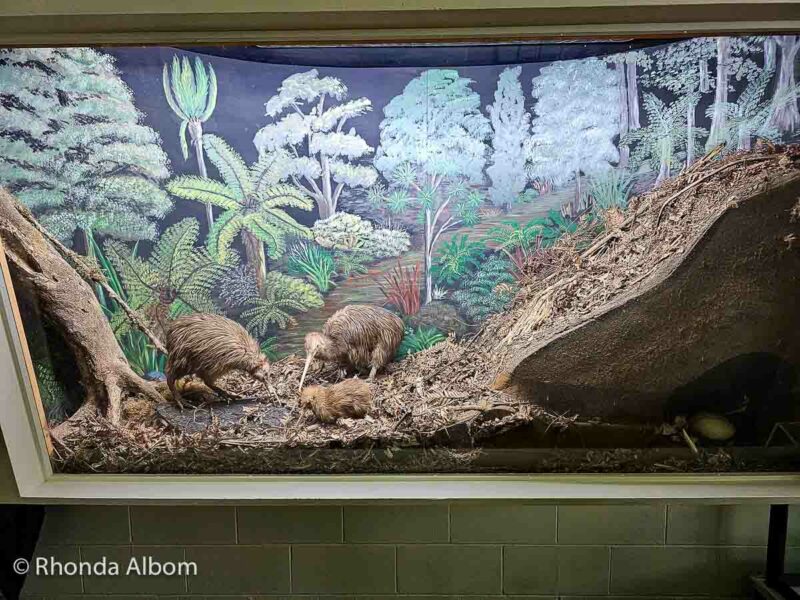
National Kiwi Centre, Hokitika
The first time we visited here was on our initial trip to the country over 20 years ago. I am almost embarrassed to admit this, but our girls were more fascinated by the opportunity to feed long-fin eels than to see another kiwi bird in a nocturnal enclosure.
Today, they also have an opportunity to catch and release freshwater crayfish. Reserve your often discounted entry to the National Kiwi Centre here.
Willowbank Wildlife Reserve, Christchurch
There is plenty that sets Willowbank Wildlife Reserve apart from the others. First, their nocturnal enclosure has no glass allowing easier viewing of the North Island Brown Kiwi that live there. Secondly, the reserve incubates up to 4 different species of kiwi bird: Rowi, Haast Tokoeka, Great Spotted Kiwi, and North Island Brown. Reserve your entry to Willowbank here.
West Coast Wildlife Centre, Franz Josef
With the Franz Josef Glacier as a dramatic backdrop, this wildlife centre focuses on the conservation of the Rowi kiwi, the rarest of all kiwi species.
In fact, they are one of the country’s largest captive rearing facilities, having raised and released nearly 200 kiwi chicks. We have not yet been here. Reserve your discounted entry here.
More places to see these iconic birds in nocturnal enclosures
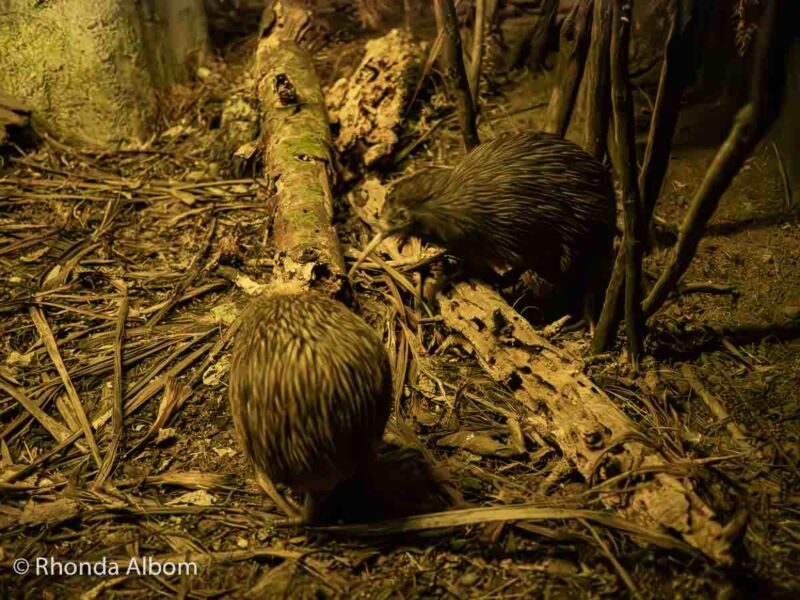
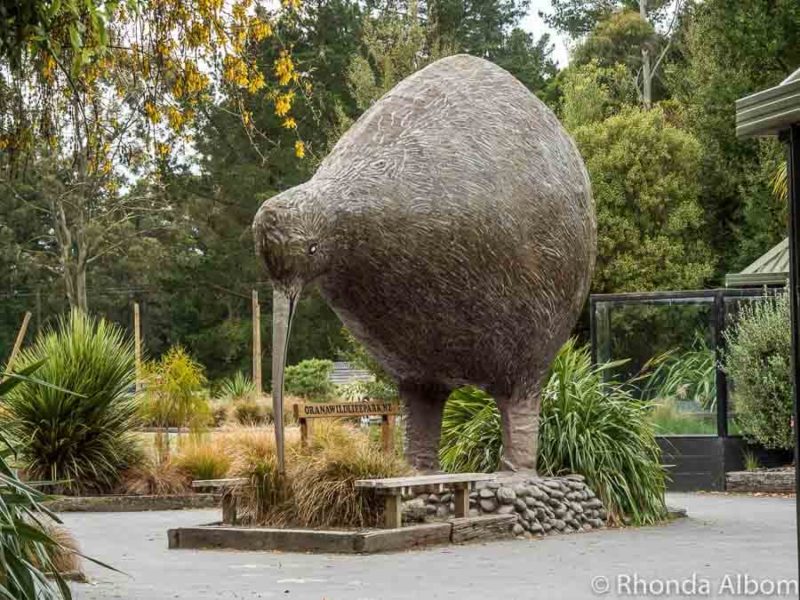
With a strong focus on conservation, these venues have a nocturnal kiwi house among a variety of other exhibits.
- Auckland Zoo
- Butterfly Creek, Auckland
- Wellington Zoo
- Te Puia, Rotorua
- National Aquarium, Napier
- Orana Park, Christchurch
- Kiwi Park, Queenstown
Tips for spotting kiwi in the wild
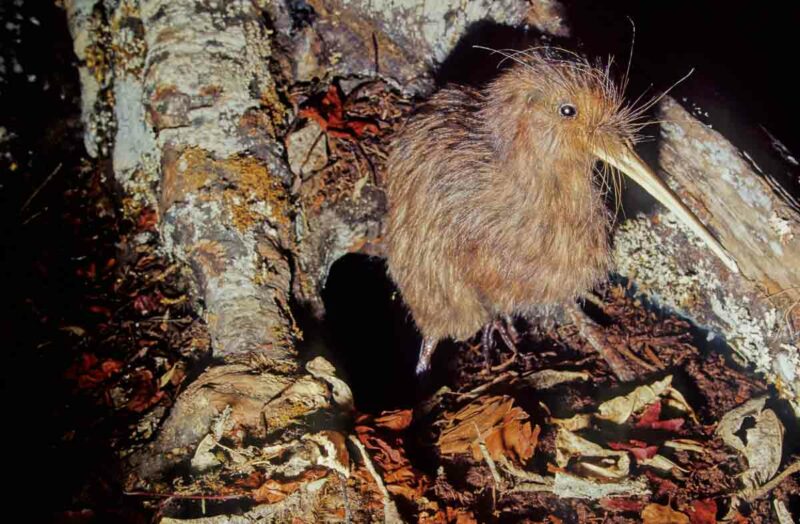
Kiwi are nocturnal and elusive, making them challenging to spot in the wild. If you want your best chance to see one, visit one of the dedicated facilities or nocturnal houses listed above. If you are looking for one in the wild or at a nature reserve, here are our best tips.
- Go on a guided night tour.
- Stay quiet and be patient. If you spot a kiwi, stay still and a few metres away. Let it come to you. Be cautious of their sharp claws.
- Listen for their distinctive calls. You can hear it here.
- Check with local conservation centres or wildlife organizations for updated information on recent kiwi sightings and recommendations for the best spots in the area.
- Bring binoculars (These are one of my favourites.)
Where to see kiwis in the wild – Nature reserves, parks, and islands
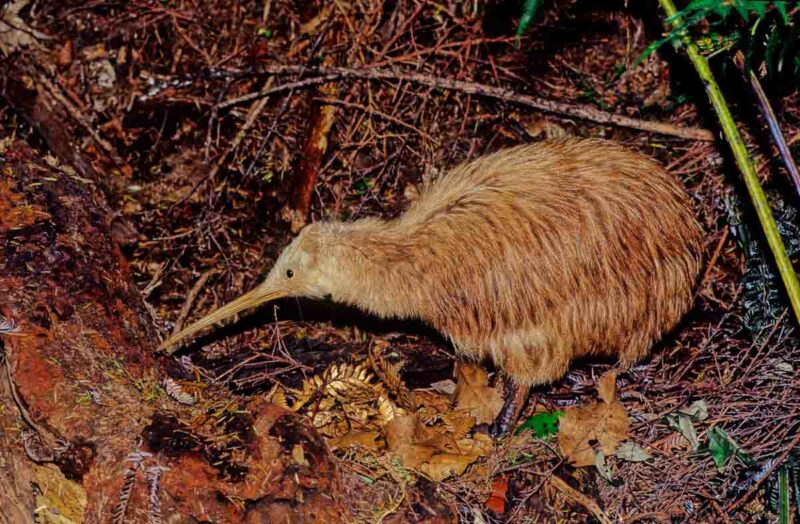
Here are some key nature reserves and areas where kiwi live.
Auckland Regional Parks
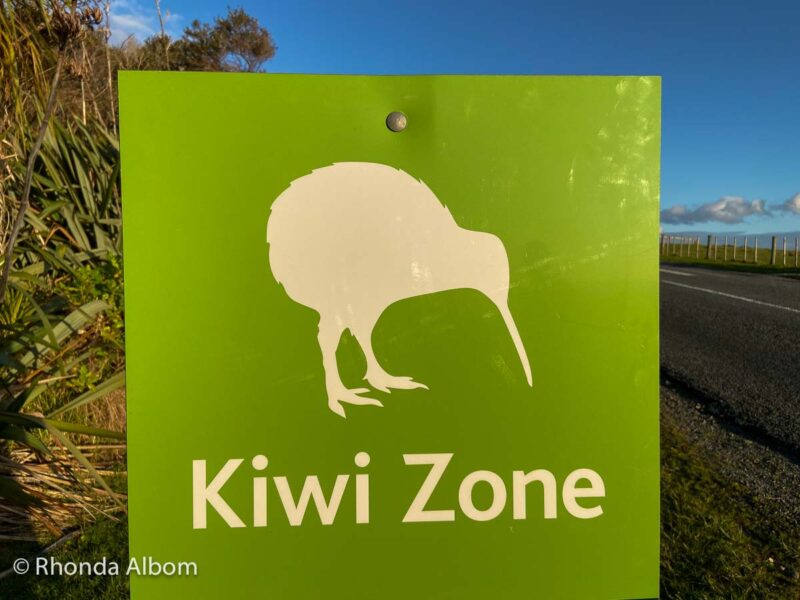
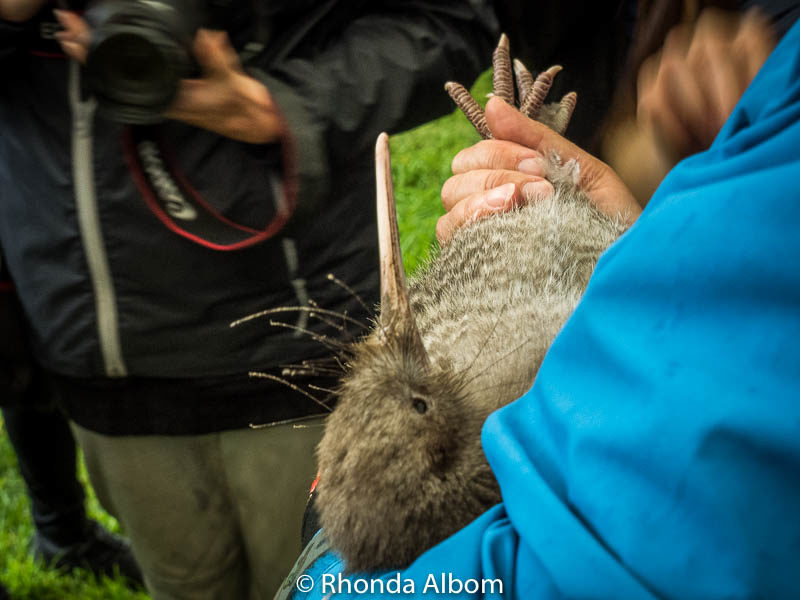
Several of the Auckland parks have developed successful pest management programmes, allowing the return of kiwi birds. Tāwharanui (North Island Brown Kiwi) and Shakespear (Little Spotted Kiwi) have preditor-proof fences protecting these national icons.
There are also North Island Brown kiwi living at Hunua Ranges, but no fence.
Seeing the birds in either park is highly unlikely without a guide, although one night, we sat quietly in a forested section of Shakespear and listened for about 45 minutes until we heard their call.
Islands of the Hauraki Gulf
Similarly, there are kiwi on several of the islands in the Hauraki Gulf. We personlly know people who have seen them on the first three in the list.
- Tiritiri Matangi
Close to home, I have been here many times, but always in the daytime. We know people who have volunteered on the island for a week, and have seen them at night. - Motuora Island
A predator-free island, it was here that my friend sat quietly, and a curious North Island Brown kiwi walked right up to her in the daytime. - Rotoroa Island
Often considered one of the best places to see kiwi birds in New Zealand. - Kiwi also live on:
While we have no personal experience, we also know they live on Kawau, Motutapu, Pōnui, Motuihe, and Little Barrier Islands.
Maungatautari Sanctuary Mountain, Waikato
Sanctuary Mountain has a 47km predator-proof fence, making it another safe haven for kiwis and other native wildlife to flourish. Evening tours offer an opportunity to enjoy one of NZ’s protected forests and the chance to hear a kiwi bird. We have not been here yet. Another option is to take a daytime tour with a kiwi encounter.
Lake Rotokare, Eltham, Taranaki
The 4km walk around Lake Rotokare is mostly bush with occasional lake views, although there is a pontoon that lets you get out over the water. Many people freedom camp here. We were told that just after dusk, there are kiwi birds walking around everywhere. Unfortunately, we arrived too early, having made it around the lake, ending about 30 minutes before sunset. We were too tired and hungry to wait, and we never saw the kiwi.
Pūkaha National Wildlife Centre, Mt Bruce, Wairarapa
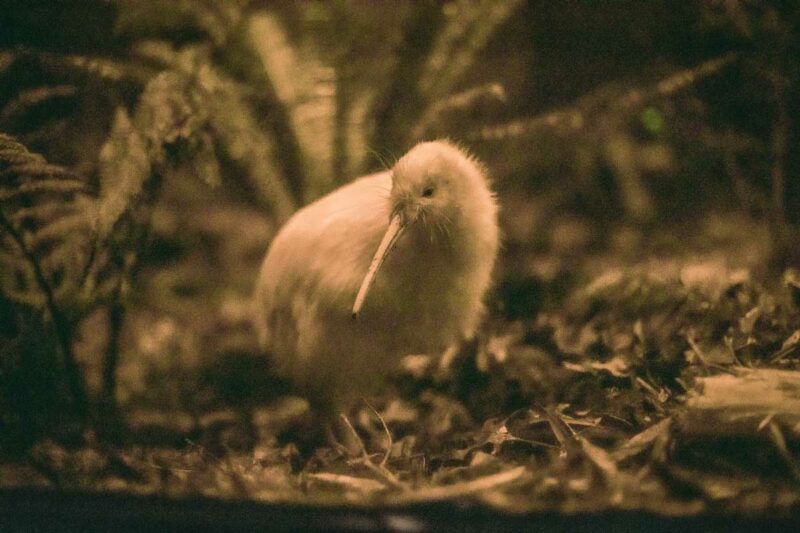
Photo credit: Miles Holden
Jeff and I visited here as we explored the Wairarapa. We opted for a daytime tour which brought us through extensive forested areas and well-maintained enclosures.
While Pūkaha National Wildlife Centre is proud of its successful breed and release kiwi programme, it’s a bird named Manukura that is one of the things that make Pūkaha special.
She is NZ’s only white kiwi (not an albino kiwi bird, but rather a Brown Kiwi that was born white). While we didn’t see her, we did see four other kiwi birds here, one pair in each of the two indoor nocturnal habitats.
We encourage you to take a tour here as well. A daytime tour is enjoyable, but their night tour offers the possibility of seeing kiwi in the wild. Reserve your often discounted entry, day or night tour here
Nga Manu Nature Reserve, Waikanae, Wellington
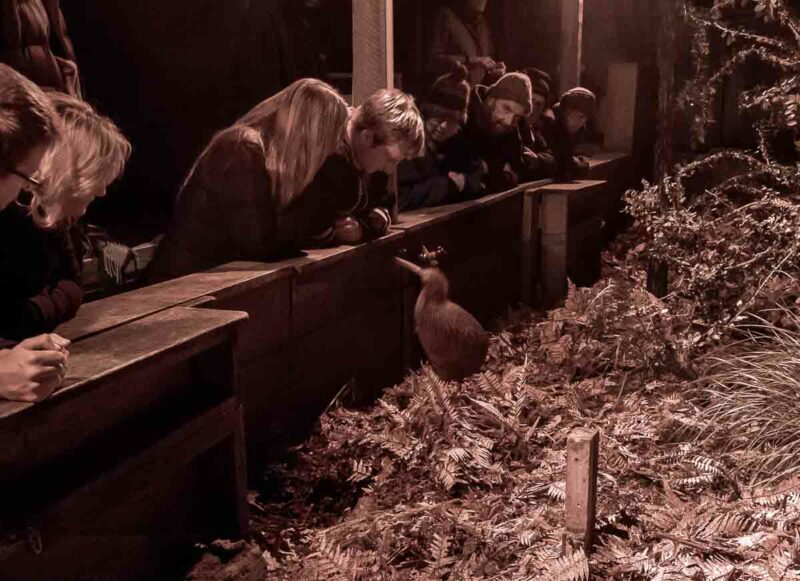
Photo supplied by Nga Manu Nature Reserve
Nga Manu’s Kiwi Encounter is one of our North Island highlights. Greeted by our guide at dusk, we first learned some fascinating kiwi facts.
Next, we took a short walk to a unique enclosure used only for night encounters. Limited to 10 people, we could all stand along the barrier, kneel on knee pads, or sit in seats and watch in silence as the kiwi bird scampered along the forest floor, thrusting its beak deep into the leaf litter as it foraged for food, unaware of us. Without glass, the experience felt more intimate than other enclosures we have seen.
If you don’t book in advance, the night encounter may be sold out when you are there, but either way, be sure to visit Nga Manu during the day. They have a nocturnal kiwi house along with a few other aviaries, a dense, green reserve, easy-to-follow trails, and a bushwalk up to an impressive lookout point.
A non-profit charitable trust, they have a successful breed and release program. Reserve your night kiwi encounter at Nga Manu here.
Zealandia Eco-Sanctuary, Wellington
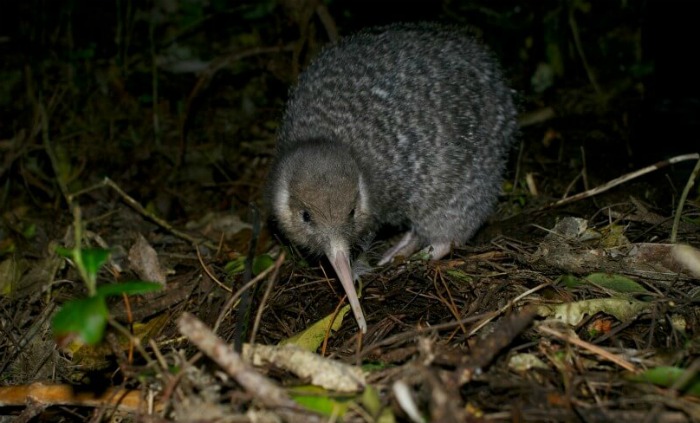
Zealandia is an ecosanctuary reminiscent of the days before humans arrived that sits on a hill above Wellington. Its predator-proof fence allows native creatures to live wild, as nature intended. There are both day and night entry options, but if you are hoping to see a kiwi, choose the night option.
I was mesmerised by our night tour of Zealandia. Unfortunately, our group didn’t see a kiwi, despite the fact that about 80% of night tours see at least one of Zealandia’s 150 little spotted kiwi.
We did see some incredible birds and other nocturnal reptiles and insects on our 2.5-hour adventure. You can read our full review here or reserve your own Zealandia wildlife night tour here.
Fiordland National Park
The dense forests and rugged landscapes of Fiordland, located in the southwestern corner of the South Island, offer another potential habitat for kiwi. The remote nature of this region makes it a suitable sanctuary for these elusive birds.
Stewart Island
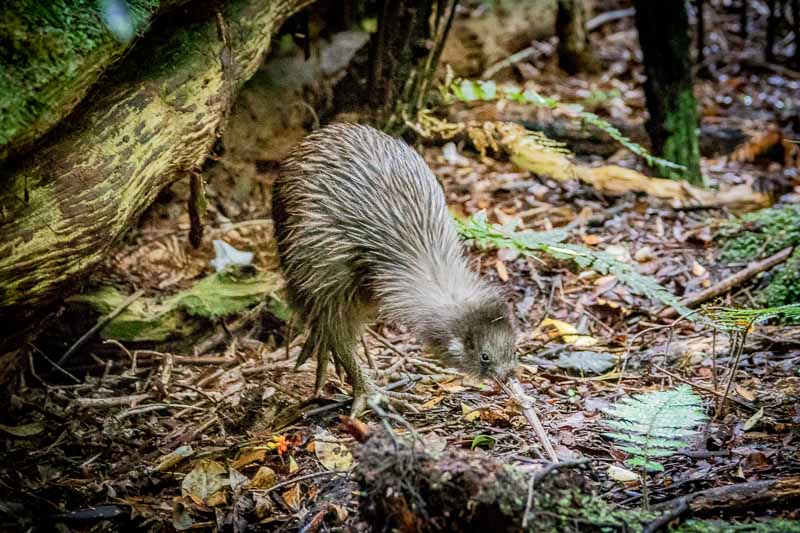
We believe that Stewart Island is the most likely spot in the country to see a kiwi bird in the wild, even in the daytime.
It’s a haven for wildlife enthusiasts. The island’s relatively pristine and predator-free environment provides an ideal habitat for Southern Brown kiwi bird (Tokoeka).
While we haven’t been yet ourselves, we have heard (and the reviews are great) that this 5-hour evening Wild Kiwi Encounter is a good choice. Starting out at dusk you will take a catamaran cruise across the inlet, then go on a guided 45-minute walk through coastal forest to a wide sandy beach where kiwi often feed among the seaweed and grasses. Reserve your Stewart Island Wild Kiwi Encounter here.
Overnight adventures to see kiwi in NZ
We have found two fabulous-sounding overnight kiwi adventures, both on the North Island.
Kapiti Island (near Wellington)
An overnight excursion to the preditor-free Kapiti Island is another great option. Located northwest of Wellington, the island is a short, 20-minute ferry ride away from Paraparaumu Beach in the Kapiti Coast.
The trip includes plenty of time for afternoon walking, a homecooked dinner, and a guided night walk on the uninhabited island. Here you will hopefully spot at least one of the 1,200 Little Spotted Kiwi on the island. Reserve your overnight tour to Kapiti Island here. (Note that there are sometimes discounts found here, but usually only in the cooler months)
Tangiaro Kiwi Retreat, Colville, Coromandel
This looks like the ultimate getaway, a piece of paradise in the Coromandel. With over 50 wild kiwi on the property, it’s highly likely you will hear the call overnight. And if that’s not enough to entice you to stay, perhaps the coastal walkway, nearby beaches, or the property’s four spa pools will be. Book your stay at Tongiaro Kiwi Retreat here.
How you can help keep kiwi in New Zealand safe
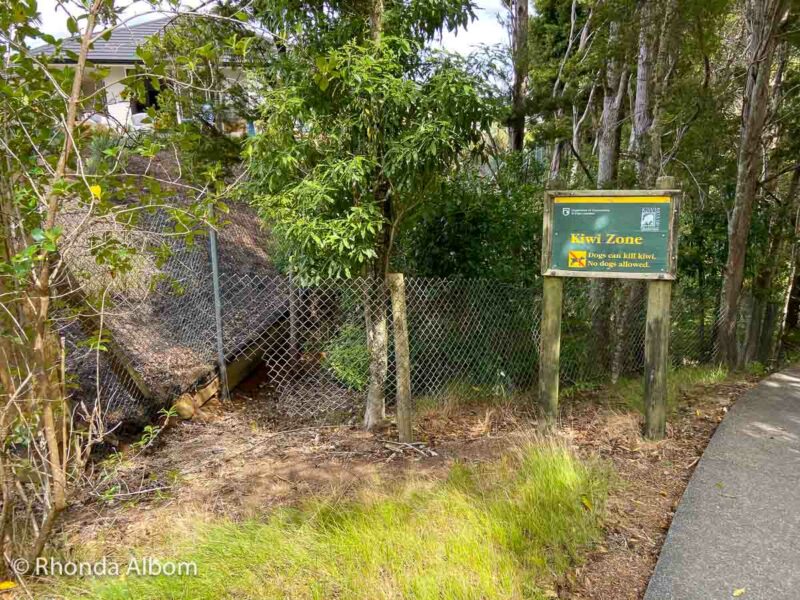
Sadly, it is humans and our dogs that pose the largest threat to kiwi in NZ. DOC offers a few tips on how we can keep our kiwi safe. Plus, we found more great tips in this Seven Sharp (TV1) interview.
- Keep dogs out of any kiwi sanctuaries and in many conservation areas where they are not allowed. If dogs are allowed, keep them on a lead and get your dog trained in kiwi aversion.
- Stick to designated paths and trails to minimize disturbance to the kiwi, their habitats, and the environment.
- Leave kiwi alone. If you spot one, stop a few metres away, but stay put even if it approaches you.
- If you take a photo, do not use a flash or a bright flashlight, as they can disorient the birds. Instead, use red-filtered lights that are less disruptive to their natural behaviour.
- Do not touch or pick up the bird (or any NZ Wildlife)
- If you spot a sick, injured, or dead kiwi, contact the emergency hotline at 0800 DOC HOT (0800 362 468).
Take the Tiaki Promise
Taiki means to care for people and place. The Tiaki Promise is a commitment to care for New Zealand, now and for future generations.
By following the Tiaki Promise, you are committing to New Zealand to act as a guardian, protecting and preserving our home. It is all our responsibility. This video explains it well.
For more on New Zealand, start here:
Where will you see kiwis in New Zealand?
Photo Credits:
All photos on this page are either shot by our team and watermarked as such or stock images from Depositphotos.

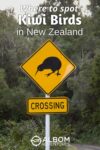
Cosette
I would love to see a kiwi in the wild. So I would have to add at least one (or several) of these spots to a New Zealand road trip!
Elyse
Aww they’re so cute! I didn’t realize there were so many places to see Kiwi’s. Stewart Island sounds the most appealing to me, I’ve saved this for next time I’m in NZ
MicheleinPlaya
This is lovely. I am an avid birdwatcher and love to see the Kiwi in New Zealand. I would particularly love to visit the Kiwi Hatchery in Rotorua. If only it wasn’t so far away. Thank you for such a thorough article.
Sue
I would love to see one of these in the wild.
Sonia
I would love a chance to see kiwi’s in person!
Melinda
I did see kiwis at Kiwi North in Whangarei, but the opportunity to see them in the wild calls to me! I am so excited to read this now as we have a few months to try to do this. What a great list!
Marga
They look amazing! And my surname sounds like them 😉 I have never seen one, but it´s a bird close to my heart!
L. Diane Wolfe
Visiting a hatchery would be neat although seeing them in the wild would be really special.